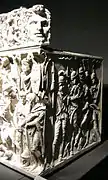Portonaccio sarcophagus
The Portonaccio sarcophagus is a 2nd-century ancient Roman sarcophagus found in the Portonaccio quarter of Rome and now held at the Museo Nazionale Romano (palazzo Massimo). Dating to around 180, the sarcophagus was likely used for the burial of a Roman general killed in the German-Sarmatic campaign of Marcus Aurelius in the years 172–175. It is an example of private sculpture of the time, with visible influences from the design of the Column of Marcus Aurelius.
| Portonaccio sarcophagus | |
|---|---|
_-_Palazzo_Museo_Massimo_(1).JPG.webp) | |
| Material | marble |
| Height | 114 cm[1] |
| Width | 239 cm |
| Depth | 116 cm |
| Created | late 2nd century AD[2] |
| Present location | National Roman Museum, Palazzo Massimo alle Terme|, Rome |
| Registration | inv. 112.327 |
History
The sarcophagus is one of a group of about twenty-five late Roman battle sarcophagi, with one exception all apparently dating to 170–210, made in Rome or in some cases Athens. These derive from Hellenistic monuments from Pergamon in Asia Minor showing Pergamene victories over the Gauls, and were all presumably commissioned for military commanders. The Portonaccio sarcophagus is the best known and most elaborate of the main Antonine group, and shows both considerable similarities to the Great Ludovisi sarcophagus, the late outlier from about 250, and a considerable contrast in style and mood.[3]
Description
The chest is very high, with all the front covered in high reliefs of combat between Romans and barbarians. The complex battle is divided into four sections: two above with Roman cavalry, one with Roman infantry, and the last and lowest with the overwhelmed barbarians. At the center, forceful lines converge on the one figure, the cavalry general charging and who does not have a carved face.
The face of the general is unfinished, either because the sculptors awaited a model to work from, or they had produced the work speculatively with no specific commission. The general and his wife are also each shown twice on the lid frieze, together holding each other's hands at the centre, and singly at the ends, again with unfinished faces.[4]
Pairs of figures of an older man and a woman stand beneath trophies at either end of the main face, uninvolved in the battle. The barbarian at right is probably Suebian (Marcomanni, Quadi, or Buri) based on his hairstyle (a Suebian knot). The barbarian on the left is either a high German or a Samartic Iazyges. These are at the same scale as the general, and all other the battling figures are smaller; indeed, in defiance of any attempt at perspective, the soldiers and horses at the "front" of the scene in the lower part are somewhat smaller than their equivalents at the "back" in the upper part.
The cover of the sarcophagus has two large acroterions depicting gargoyles and is decorated with a low-relief frieze that depicts a life story (the presentation of a baby to its mother, his education, marriage, and a dedication to Clementia). The face, as on the main sarcophagus, is not depicted.
Gallery
 Left side
Left side Right side
Right side Detail of front, to left
Detail of front, to left Detail of front, to centre, with the general
Detail of front, to centre, with the general Detail of front, to right
Detail of front, to right Detail of barbarians
Detail of barbarians

 Trophies at the side of the front
Trophies at the side of the front_-_Palazzo_Museo_Massimo_(1b).JPG.webp)
_-_Palazzo_Museo_Massimo_(2).JPG.webp)
_-_Palazzo_Museo_Massimo_(2b).JPG.webp)
_-_Palazzo_Museo_Massimo_(3).JPG.webp)
_-_Palazzo_Museo_Massimo_(6b).JPG.webp)
References
| Wikimedia Commons has media related to Portonaccio sarcophagus. |
- Mark D., Fullerton (2020). Art and Archaeology of the Roman World. Thames & Hudson. p. 313. ISBN 9780500051931.
- Mark D., Fullerton (2020). Art and Archaeology of the Roman World. Thames & Hudson. p. 313. ISBN 9780500051931.
- Strong, Donald, et al., Roman Art, 1995 (2nd edn.), p. 205, Yale University Press (Penguin/Yale History of Art), ISBN 0300052936
- Henig, Martin (ed), A Handbook of Roman Art, p. 93, Phaidon, 1983, ISBN 0714822140